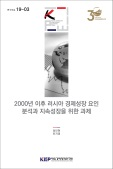Working Papers
Publications
Working Papers
To list

Russian Economic Growth after 2000: Assessment and Suggestions
economic development, economic cooperation
Author Minhyeon Jeong and Jiyoung Min Series 19-03 Language Korean Date 2019.06.21
This paper investigates Russian economic growth after 2000. We first identify growth regimes of the Russian economy between 2000 and 2014 by using the break-point estimation. Russia’s economic growth during the period turns out to have three different regimes, the first, second and third of which are 2000-03, 2004-07 and 2008-14, respectively. We notice through growth accounting that total factor productivity (TFP, henceforth) led growth during the first regime in terms of its contribution to growth. However, TFP’s contribution to growth has diminished since the second regime, while capital accumulation has contributed to growth the most.
To figure out the driving force behind the findings from growth accounting, we take a careful look at critical economic events and policy changes that could affect TFP during the period. We find that there were extensive institutional reforms for efficient administration and taxation system in the first regime, which would promote TFP at large. On the contrary, the Russian government started to intervene resource allocations in the market especially by nationalizing large energy corporations in the second regime and Russian economy’s reliance on the energy sector has increased, both of which would undermine TFP growth.
Actually, we find that the production and export shares of mid- and high-tech manufacturing in the Russian economy begun to shrink from the second regime, while the export share of fuel increased rapidly. Related to this, we measure institutional barriers of Russia that prevent adoptions of technology and knowledge from foreign countries and found that the barriers are the smallest in the first regime while the largest in the second regime.
We then revisit the growth effects of trade to find befitting growth implications for the Russian economy. To address the endogeneity, we use the dynamic panel GMM method and confirm the positive growth effects of trade. Particularly, it boosts both income and TFP growth for a middle-income country such as Russia to increase goods import from high-income countries, which are stronger in mid- and high-tech manufacturing in overall. We also provide empirical evidence that more goods import from high-income countries fosters domestic mid- and high-tech manufacturing industries. These empirical findings indicate that the Russian economy can deal with the stagnation of TFP growth more effectively by expanding goods trade with high-income countries such as Korea.
To figure out the driving force behind the findings from growth accounting, we take a careful look at critical economic events and policy changes that could affect TFP during the period. We find that there were extensive institutional reforms for efficient administration and taxation system in the first regime, which would promote TFP at large. On the contrary, the Russian government started to intervene resource allocations in the market especially by nationalizing large energy corporations in the second regime and Russian economy’s reliance on the energy sector has increased, both of which would undermine TFP growth.
Actually, we find that the production and export shares of mid- and high-tech manufacturing in the Russian economy begun to shrink from the second regime, while the export share of fuel increased rapidly. Related to this, we measure institutional barriers of Russia that prevent adoptions of technology and knowledge from foreign countries and found that the barriers are the smallest in the first regime while the largest in the second regime.
We then revisit the growth effects of trade to find befitting growth implications for the Russian economy. To address the endogeneity, we use the dynamic panel GMM method and confirm the positive growth effects of trade. Particularly, it boosts both income and TFP growth for a middle-income country such as Russia to increase goods import from high-income countries, which are stronger in mid- and high-tech manufacturing in overall. We also provide empirical evidence that more goods import from high-income countries fosters domestic mid- and high-tech manufacturing industries. These empirical findings indicate that the Russian economy can deal with the stagnation of TFP growth more effectively by expanding goods trade with high-income countries such as Korea.
Sales Info
| Quantity/Size | 86 |
|---|---|
| Sale Price | 5 $ |
 공공저작물 자유이용허락 표시기준 (공공누리, KOGL) 제4유형
공공저작물 자유이용허락 표시기준 (공공누리, KOGL) 제4유형
대외경제정책연구원의 본 공공저작물은 "공공누리 제4유형 : 출처표시 + 상업적 금지 + 변경금지” 조건에 따라 이용할 수 있습니다. 저작권정책 참조
